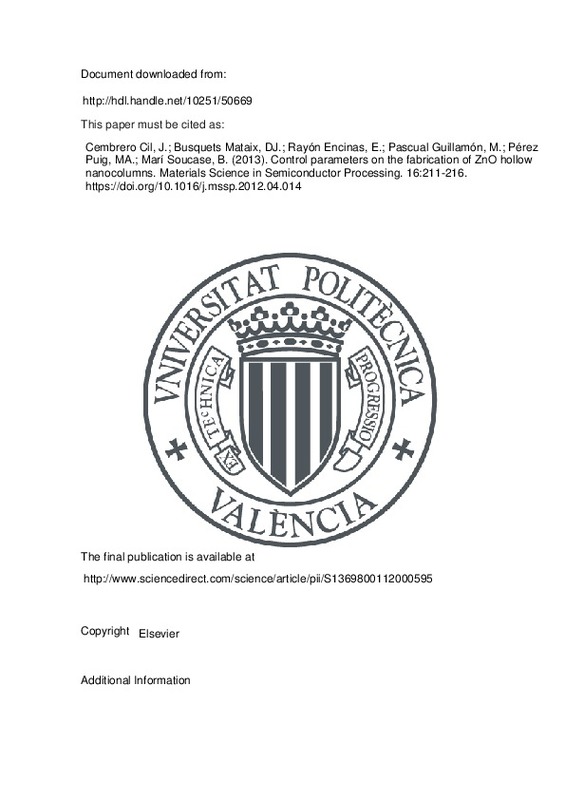Cembrero Cil, J.; Busquets Mataix, DJ.; Rayón Encinas, E.; Pascual Guillamón, M.; Pérez Puig, MA.; Marí Soucase, B. (2013). Control parameters on the fabrication of ZnO hollow nanocolumns. Materials Science in Semiconductor Processing. 16:211-216. https://doi.org/10.1016/j.mssp.2012.04.014
Por favor, use este identificador para citar o enlazar este ítem: http://hdl.handle.net/10251/50669
|
Título:
|
Control parameters on the fabrication of ZnO hollow nanocolumns
|
|
Autor:
|
Cembrero Cil, Jesús

 Busquets Mataix, David Jerónimo
Busquets Mataix, David Jerónimo

 Rayón Encinas, Emilio
Rayón Encinas, Emilio

 Pascual Guillamón, Manuel
Pascual Guillamón, Manuel
 Pérez Puig, Miguel Angel
Pérez Puig, Miguel Angel

 Marí Soucase, Bernabé
Marí Soucase, Bernabé
|
|
Entidad UPV:
|
Universitat Politècnica de València. Departamento de Ingeniería Mecánica y de Materiales - Departament d'Enginyeria Mecànica i de Materials
Universitat Politècnica de València. Departamento de Física Aplicada - Departament de Física Aplicada
|
|
Fecha difusión:
|
|
|
Resumen:
|
[EN] The present work reports on the fabrication of hollow ZnO nanocolumns by a sequential combination of electrochemical deposition, chemical attack and regeneration. Initially, ZnO nanocolumns were deposited in two ...[+]
[EN] The present work reports on the fabrication of hollow ZnO nanocolumns by a sequential combination of electrochemical deposition, chemical attack and regeneration. Initially, ZnO nanocolumns were deposited in two different substrates, namely Fluor Tin Oxide and Indium Tin Oxide. In a further step, a statistical analysis on the most influencing control parameters in the dissolution stage to produce the hollow ZnO nanowires on the FTO substrates was carried out. The control variables considered were electrolyte concentration, dissolution time and temperature, whereas the output variable was the percentage of the hollow nanocolumns obtained. The statistical analysis consisted of a two-level factorial design of experiments on three variables, therefore involving a series of 8 experiments. An analysis of variance (ANOVA) on the results was also carried out. The results showed that all the control variables were significant, the most important being the dissolution time.
[-]
|
|
Palabras clave:
|
ANOVA
,
two-level factorial design
,
Hollow ZnO nanocolumns
,
Semiconducting II–VI materials
,
Zinc compounds
,
Oxides
,
Growth from solutions
,
Nanostructures
,
Electron Microscopy Service of the UPV
|
|
Derechos de uso:
|
Reserva de todos los derechos
|
|
Fuente:
|
Materials Science in Semiconductor Processing. (issn:
1369-8001
)
|
|
DOI:
|
10.1016/j.mssp.2012.04.014
|
|
Editorial:
|
Elsevier
|
|
Versión del editor:
|
http://www.sciencedirect.com/science/article/pii/S1369800112000595
|
|
Código del Proyecto:
|
info:eu-repo/grantAgreement/EC/FP7/269279/EU/Development of a new generation of CIGS-based solar cells/
info:eu-repo/grantAgreement/Generalitat Valenciana//PROMETEO09%2F2009%2F063/ES/Investigaciones en diseño para la fabricación y producción automatizada/
info:eu-repo/grantAgreement/MICINN//MAT2009-14625-C03-03/ES/Diseño, Sintesis Y Caracterizacion De Materiales Fotovoltaicos Avanzados De Alta Eficiencia/
|
|
Agradecimientos:
|
This work was supported by the Spanish Government through MCINN Grant MAT2009-14625-C03-03, Generalitat Valenciana programme PROMETEO/2009/063 and European Commission through NanoCIS project FP7-PEOPLE-2010-IRSES (ref. ...[+]
This work was supported by the Spanish Government through MCINN Grant MAT2009-14625-C03-03, Generalitat Valenciana programme PROMETEO/2009/063 and European Commission through NanoCIS project FP7-PEOPLE-2010-IRSES (ref. 269279). Technical support given to the authors by the Servei de Microscopia at the Universitat Politecnica de Valencia (Spain) is greatly acknowledged.
[-]
|
|
Tipo:
|
Artículo
|







![[Cerrado]](/themes/UPV/images/candado.png)


